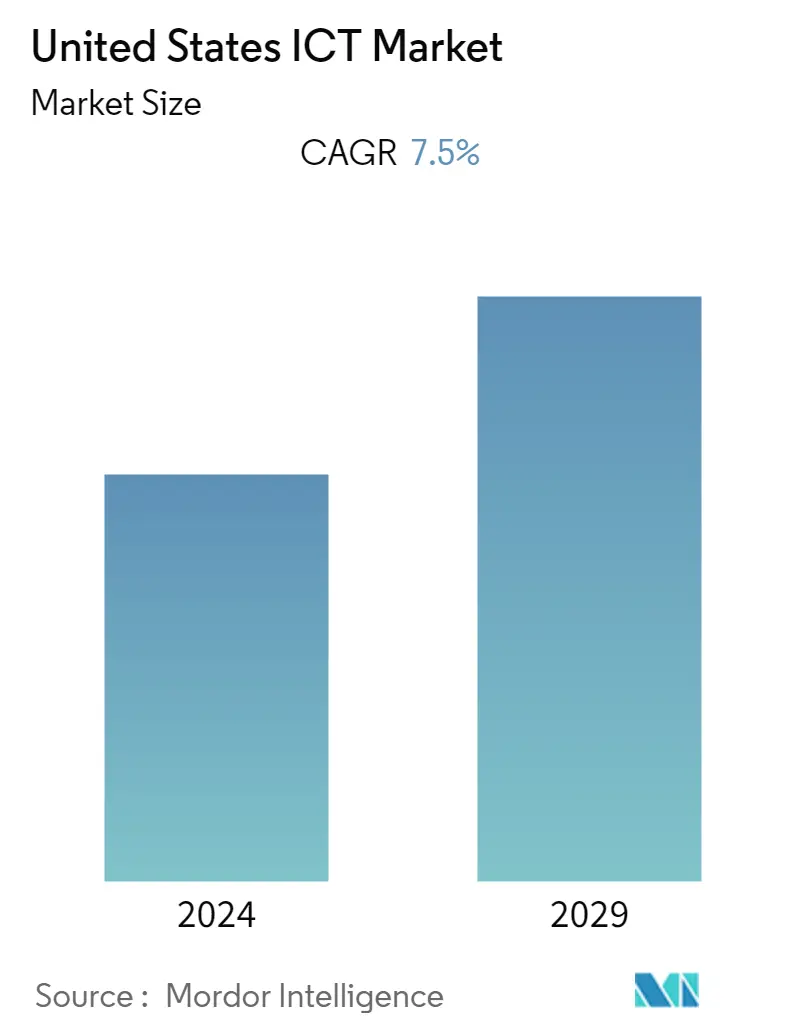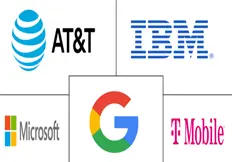Market Size of United States ICT Industry

| Study Period | 2019 - 2029 |
| Base Year For Estimation | 2023 |
| Forecast Data Period | 2024 - 2029 |
| Historical Data Period | 2019 - 2022 |
| CAGR | 7.50 % |
| Market Concentration | Low |
Major Players
*Disclaimer: Major Players sorted in no particular order |
Need a report that reflects how COVID-19 has impacted this market and its growth?
US ICT Market Analysis
The US CT market revenue is expected to grow at a CAGR of 7.5% during the forecast period. Most major telecom companies in the world, such as AT&T, IBM Corp, Microsoft, and T-Mobile, are based out of the United States and promote innovation by consistently making significant R&D investments. The US ICT sector, which underpins the operations of all enterprises, public safety groups, and the government, is the backbone of the country's economy.
- The United States is the largest technology market in the world. Although information and communication technology (ICT) is present everywhere, it plays a significant role in the economic development of the United States. The ICT market in the United States was projected to represent approximately 35% of the world in 2022. Since the post-World War II industrial revolution, innovation has been a defining characteristic of the Unites States' competitiveness and has fueled the country's global dominance.
- The computer and information technology and telecommunications industry in the United States has a reputation for developing dependable and efficient products that reach the market quickly. The United States market attracts the attention of numerous international corporations with its strict enforcement of intellectual property regulations. The software and tech services sectors account for over half the spending in the country's tech market. With a stable overseas market share, US businesses dominate the global packaged and custom software marketplaces and are competitive in all other market areas.
- The "digital economy" concept refers to products and services that incorporate or are produced utilizing digital technologies. The information and communications technology (ICT) sector supports the digital economy and is a reliable barometer of the country's economic growth. In this digital era, the competitive advantage of the United States would be driven by innovation, entrepreneurial dynamism, information, and ICT production.
- However, trade disputes have permeated the technology sector, with measures adopted by the Trump and Biden administrations to stop Chinese firms from purchasing American semiconductor manufacturing processes and machinery. The relationship between China and the United States continue to deteriorate, which could have a detrimental impact on global ICT/electronics supply chains and result in technological differences (such as the deployment of 5G) and reduced productivity.
- Encouragingly, government investment in 2022 would devote a sizeable portion to improving information technology system innovation and cyber security. According to a GovConWire report, the federal government of the United States allocated about USD 58.44 million for the fiscal year 2022 to meet the information technology requirements of civilian federal government agencies. Cyber security investments take up a large portion of the US government's technology budget. The funding for cyber security in 2021 was nearly USD 18.78 billion.
- The COVID-19 pandemic significantly impacted the US technology and telecommunication industry and other facets of daily life . The pandemic substantially harmed the country's technology industry, influencing the availability of raw materials, upsetting the electronics value chain, and increasing the danger of inflation for goods. The disruption accelerated remote work and shifted attention to quickly assessing and de-risking the entire value chain. A large portion of the US population were forced to spend constant time at home due to the pandemic, which increased remote jobs, telemedicine, online education, and streaming in-home entertainment. The high demand for mobile and residential broadband access bolstered the telecommunication sector.
